Ear wax, also known as cerumen, plays a crucial role in protecting the ears by trapping dust, debris, and bacteria. While it is a natural and beneficial substance, excessive buildup can lead to discomfort, hearing issues, and infections. Many people attempt to remove ear wax using unsafe methods, which can cause more harm than good. Understanding the right and wrong ways to manage ear wax is essential for maintaining ear health.
This guide covers the do’s and don’ts of Ear Wax Removal Dubai, safe practices, benefits, and post-treatment care to ensure optimal ear hygiene.
Do’s of Ear Wax Removal
1. Use Ear Drops for Softening Wax
One of the safest ways to manage ear wax is by using ear drops designed to soften and break down the buildup. These drops typically contain mineral oil, hydrogen peroxide, or saline solution, which help loosen the wax for natural removal. Using ear drops as per instructions can prevent blockages and reduce the need for invasive removal techniques.
2. Allow the Ears to Self-Clean
Ears are naturally self-cleaning, and in most cases, ear wax exits the ear canal on its own. Jaw movements, such as chewing and talking, help push wax to the outer ear, where it dries and falls out. Unless there is an obstruction, avoiding unnecessary interference is the best approach.
3. Consult a Professional for Excessive Wax Buildup
If ear wax accumulation leads to discomfort, hearing difficulties, or a feeling of fullness in the ear, seeking professional assistance is recommended. Healthcare providers use specialized tools and techniques, such as irrigation or microsuction, to safely remove excess wax without causing damage.
4. Maintain Regular Ear Hygiene
Keeping the outer ear clean and dry helps prevent infections and wax buildup. Use a damp cloth to wipe the external ear, avoiding insertion into the ear canal. Regular ear hygiene practices can contribute to overall ear health.
5. Stay Hydrated and Eat a Healthy Diet
Hydration and a well-balanced diet support ear health by maintaining natural wax consistency. Drinking enough water and consuming foods rich in omega-3 fatty acids and vitamins can help prevent excessive wax production and ear canal dryness.
Don’ts of Ear Wax Removal
1. Avoid Using Cotton Swabs or Q-Tips
Cotton swabs are commonly used for ear cleaning, but they can push wax deeper into the canal, leading to blockages and possible eardrum damage. This practice may also cause irritation and increase the risk of infections.
2. Do Not Insert Sharp Objects into the Ear
Items like hairpins, tweezers, or keys should never be used to remove ear wax. These objects can scratch the delicate ear canal lining, increasing the likelihood of infections and injuries.
3. Avoid Excessive Ear Cleaning
Frequent and aggressive ear cleaning can disrupt the natural balance of ear wax production, leading to dryness, irritation, or overproduction of wax. Unless there is an issue, minimal intervention is best.
4. Refrain from Using Ear Candles
Ear candling is often promoted as a natural way to remove wax, but it poses significant risks. This method involves placing a lit, hollow candle into the ear canal, which can lead to burns, ear canal obstructions, and eardrum perforations.
5. Do Not Ignore Signs of Infection
Symptoms such as ear pain, drainage, itching, and persistent hearing loss may indicate an infection or underlying issue. Ignoring these signs and attempting to self-treat can worsen the condition. Seeking medical advice is essential when experiencing discomfort.
Benefits of Proper Ear Wax Removal
Improved Hearing: Excess wax can block sound waves, leading to temporary hearing loss. Safe removal restores auditory clarity.
Reduced Risk of Infections: Proper hygiene minimizes bacteria accumulation and prevents infections.
Enhanced Comfort: Removing excess wax relieves pressure, discomfort, and the sensation of a blocked ear.
Better Balance and Coordination: The ears play a role in maintaining balance; excessive wax can cause dizziness and imbalance.
Prevention of Earache and Tinnitus: Managing ear wax buildup can help avoid pain and ringing in the ears.
Post-Treatment Care for Healthy Ears
After professional Ear Wax Removal in Dubai, proper aftercare ensures long-term ear health:
Keep Ears Dry: Avoid inserting water into the ears for at least 24 hours after treatment.
Avoid Loud Noises: Sensitive ears may be more prone to discomfort after wax removal. Protect your ears from excessive noise exposure.
Refrain from Inserting Foreign Objects: To prevent further buildup and irritation, avoid inserting anything into the ear.
Follow Professional Advice: If prescribed ear drops or other care instructions, follow them to maintain ear health.
Schedule Regular Check-Ups: If prone to excessive ear wax, regular visits to a healthcare provider can help prevent blockages.
Conclusion
Maintaining ear health starts with understanding the right and wrong ways to handle ear wax. While some at-home methods can aid in wax management, improper removal techniques can cause harm. Safe practices, such as using ear drops, seeking professional assistance, and allowing the ears to self-clean, are key to avoiding complications.u





Comments